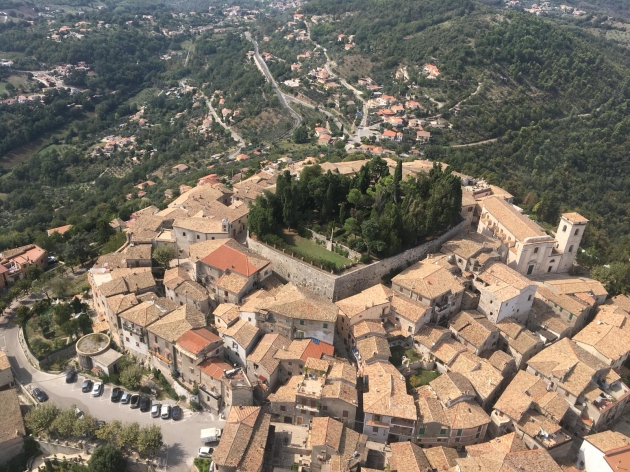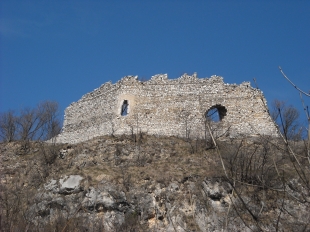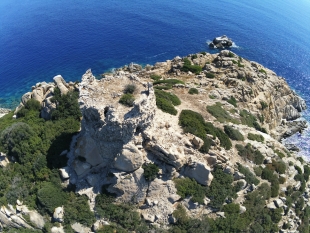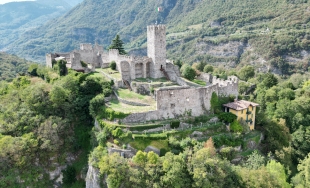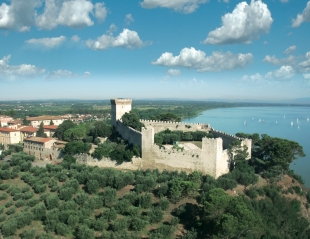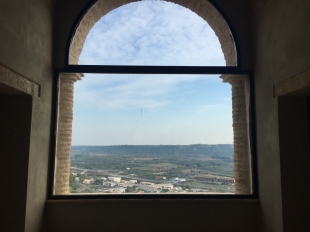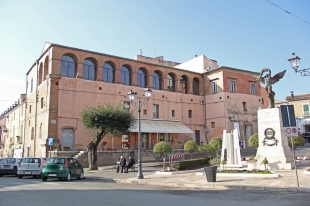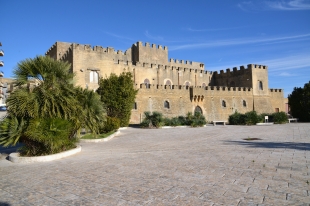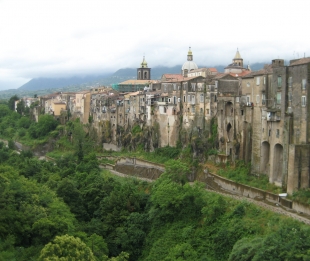» archive clients
-
Home from Home - JAMESPLUMB at Rossana Orlandi
date: 01-10-2010
National Days of Italian Castles return on May 10 and 11
42 main architectures and sites spread over 19 Italian regions, in Campania the Castles Month
The great national treasure of history and architecture composed of castles, fortresses, towers and walled villages will be revealed to Italians and tourists on Saturday 10 and Sunday 11 May 2025 with the 26th edition of the National Days of Italian Castles.
The volunteers of the organizing non-profit organization, the Italian Castle Institute, which celebrated 60 years of activity in 2024, will open the doors of publicly and privately owned fortified architecture - from north to south of the country, including the islands - with free guided tours, conferences, book presentations and conversations, cultural treks to discover, on foot or bikes, sites and villages.
The event, which has now won over enthusiasts of architecture, restoration, history and heraldry of all ages, is conceived and conducted in collaboration with associations, municipalities and other public bodies in order to raise awareness and promote this incredible cultural heritage: Italy boasts, more than other countries, a significant number of fortified buildings of historical and archaeological importance. Cultural assets that often positively influence the tourist fortunes of the place where they have been located for centuries.
‘We reveal the 42 sites and many collateral events that each regional office of the Italian Castle Institute has selected after careful analysis and after consulting our scientific archive that contains thousands of fortified architectures surveyed and studied with a multidisciplinary approach for which we are known to specific stakeholders both in our country and abroad.’ says Michaela Marullo Stagno d’Alcontres, president of the Italian non-profit organization ‘This year, our guided tours will tell of communities of mankind and interests, of global anthropo-geographic unicums where the presence of man extends from the Paleolithic (such as the Pettorano valley on the Gizio river, at the gates of L’Aquila) to today.
We will tell border stories with two architectures that look at each other, in the year of Capital of Cross-border Culture in Friuli, such as the Castle of Gorizia and the castle of Kromberk while in Campania we organize the month of castles that allows three more weekends with visits to a further 12 castles, eight small villages and the capital city that celebrates 2500 years of foundation.'
The National Days of Italian Castles 2025 offer an intense cultural, historical and architectural study in a time of crisis and upheaval. They offer a journey of exploration of ethnographic traditions, often on foot, by cycle path and with other sustainable mobility.
The Italian Castle Institute proposes a different journey into memory and the future, ancient and contemporary, every year, telling of beauty as a shared, regenerating and rebirth value. The journey also tells of the generations that animate local communities, our networks of collaboration and friendship that make the Days possible.
The visit to fortresses, ancient or modern, does not echo the dark tones of war that have become daily news but tells how a territorial element that was long repulsive has found a new function, becoming an inclusive landmark.
Today, forts are open places and synonymous with hospitality and knowledge, where the hosts are often associations and public bodies that animate them all year round with educational and cultural projects. These architectures are also synonymous with eclecticism and variability depending on the historical periods in which they were built.
In some cases, they express a considerable tourist figure that attracts visitors from nearby cities, in others they are at the center of sustainable mobility projects. Numerous cycle paths are involved in the routes of the 2025 Days, such as the Sole and Del Garda cycle path in Veneto and the Trasimeno ring in Umbria. The best asset of our future is the enhancement of our landscape.'
The National Days of Italian Castles are accompanied by other annual activities that the institute has planned and financed since its foundation, such as the Degree Award for students who have distinguished themselves with theses on fortified architecture in restoration and other disciplines. Study meetings and photography seminars are dedicated to secondary school students; for enthusiasts of scientific research, the editorial series and the numerous courses that the Institute's volunteers carry out in the 22 IIC offices located in 20 Italian regions.
In Abruzzo, a region rich in watchtowers, the Italian Castle Institute invites you to rediscover the Cantelmo castle (9th century) with a guided tour on Saturday 10 May 2025, restored in 1998 as part of the larger restoration program 'Sulmona city of Art' financed by Law 64/86. Rebuilt by the Superintendence, it dominates the Guardiola hill inside one of the most beautiful fortified villages in Italy, Pettorano sul Gizio. (AQ). Today it is publicly owned and is immersed in the surrounding national park.
The castle of Sannicandro is the protagonist of the Days in Apulia: about 15 kilometers from Bari, on Sunday 11 May guided tours and a meeting at the castle that dates back to the Norman-Swabian period on the pre-existing Byzantine perimeter perfectly legible. The manor is completely recovered and restored after an enhancement activity that 25 years ago was deemed worthy of the plaque of the Italian Castles Institute. At 10.30, open to the public and free of charge, the multi-voiced meeting The castle yesterday, today, tomorrow.... from oblivion to new life takes stock of the work carried out, on how the castle works 25 years after its restoration and sees the participation of the Mayor of Sannicandro Arch. Giuseppe Giannone, of the arch. Antonella Calderazzi (Italian Castles Institute) and of the Eng. Giambattista Titta De Tommasi (President of the Italian Castles Institute, Puglia section) author of the restoration. Guided tours begin at 11:30 and will be conducted in small groups by experts from the Istituto Italiano Castelli, while in the afternoon the public has free access.
On this occasion, the Carta dei Castelli di Puglia (Adda editore 2025) will be presented and sold, edited by architects Marina De Marco and Antonella Calderazzi.
The castle of Bernalda (MT), built in the 4th century AD, dominates the Basento valley in Basilicata: the current fortification dates back to the Aragonese age and has incorporated pre-existing Norman and Angevin structures that in turn arose on a site already fortified in the late ancient age.
Also Torre di Mare, once in the ancient Greek city of Metaponto animated by guided tours of the two architectures protagonists both Saturday 10 and Sunday 11 May.
Rocca Imperiale is the protagonist of the activities planned in Calabria: perched on a hill with the houses scenically arranged in concentric circles, it is well preserved and is dominated by its castle from the Frederick era, recently restored.
On Saturday 10 May free guided tours without reservation, at 6 pm round table on the restoration and enhancement of castles, in particular that of Rocca Imperiale.
On Sunday 11 May morning, reserved only for members of the Istituto Italiano dei Castelli onlus, an excursion to the Santuario della Madonna delle Armi in Cerchiara di Calabria is scheduled, while in the afternoon a visit to a fortified farmhouse in the area.
The Calabria section of the Istituto Italiano dei Castelli has chosen to return to visit the fortification more than a decade after the first Days held in the same place, because the castle was subsequently the subject of restoration work. Today the visit allows anyone to appreciate almost entirely the volume of the seventeenth-eighteenth century residence built inside the fortified structures, but above all to access the underground areas, the internal rooms of the towers on the eastern front and the corridor that connects them, with the possibility of viewing the crossfire system that could be implemented for defense.
The imposing and complex fortification that stands at the top of the town, dominating it with its mass, is in fact the result of multiple transformations that have followed one another over the centuries.
Campania participates in the Days by telling the story of the Irpinian castles with an itinerary on the castles of the Sabato valley focused on the fortified architecture in the province of Avellino, in particular the castles of San Barbato, Montefusco, Tufo, Summonte, Mercogliano, Montefredane. They will be protagonists with extraordinary openings on Saturday 10 and Sunday 11.
Saturday 10 May, the castle of Montefredane hosts a round table dedicated to the knowledge and enhancement of the castles of the Sabato valley followed by an organ concert in the mother church. The Caracciolo castle, already mentioned in the year 1000, stands on a rock that dominates the valley: restored, it has a water cistern and constitutes an extraordinary panoramic point of view over the entire surrounding territory.
In this region, the volunteers of the Italian Institute of Campania Castles have organized the May of the castles with dedicated programs every weekend.
Sunday 4 May, a guided tour of the beautiful fortified village of Sant’Agata dei Goti (BN) which will also include the medieval castle.
Saturday 17 May, special guided tours of the Norman castle of Marigliano (NA).
Sunday 18 May, guided tours of Castel Sant’Elmo (NA) while Agropoli (SA) hosts a round table in the council chamber of the Municipality followed by a visit to the suggestive fortified historic center.
Saturday 24 May guided tours of the castle and village of Francolise (CE) and round table.
Saturday 31 May visits to the grandiose castle of Teggiano (SA), from the Angevin era and later transformed by the Aragonese. The village was surrounded by a wall consisting of twenty cylindrical towers, some of which survive today incorporated into modern buildings.
The Rocca di Meldola (FC), is the protagonist of the National Castle Days in Emilia Romagna. Of uncertain dating between the 10th and 12th centuries, purchased by the Municipality in 1995, it stands on the village of Meldola (1000 meters above sea level). The Days will be an opportunity to visit recently restored spaces that are not yet permanently open to the public.
A round table is scheduled for Saturday, May 10, followed by an aperitif on the terrace of the Rocca.
Guided tours every hour on Sunday, May 11 from 9:30 to 18:30, admissions are on a first-come, first-served basis.
The Forlì area is very rich for further independent visit itineraries. Meldola is the gateway to exploring the Bidente valley with villages such as Cusercoli, Civitella di Romagna, Santa Sofia, Galeata, among ruins of castles, monasteries and splendid Apennine landscapes, up to the dam and lake of Ridracoli and the Casentinesi Forests park. Recommended, in particular, the fortress and fortified village of Teodorano (1000 years old) on the Voltre valley, the tower and the ruins of the castle of Borgo di Castelnuovo, the Bosco di Scardavilla Regional Reserve (1991) of about 30 hectares.
Friuli Venezia Giulia celebrates the important nomination of Gorizia-Nova Gorica as European Capital of Cross-border Culture.
The Italian Institute Castelli Friuli Venezia Giulia will lead enthusiasts and visitors to discover the Castle of Gorizia (11th century). From the fortified hill the view extends on one side to the city of Gorizia and on the other, in Slovenia, to the monastery of Castagnevizza (burial place of six members of the Bourbon family of France) and Villa Lasciac.
A further stop on this "two borders" route is the castle of Kromberk, a few kilometers from Nova Gorica (13th century), now a museum.
The splendid castle of Fumone (FR) is open to guided tours organized by the Istituto Italiano Castelli Lazio on Saturday 10 May.
The manor, excellently preserved and privately owned, still belongs to the Longhi de Paolis family who redeemed it from the first (papal) ownership. Situated 800 metres above sea level on a hill overlooking the Via Latina, it is the castle located at the highest altitude above sea level open to visits during the 2025 Days.
In Liguria, guided walking tours of Finale Alta and Bassa, Saturday 10 May all day.
In Lombardy, the protagonist is the castle of Breno (11th-16th century) and Valcamonica valley: in addition to guided tours of the castle, the air-raid shelter and the headquarters of the Camuno Museum, a conference on the fortifications of Valcamonica is planned, followed by recreational activities with archers aimed at young people and children, a brass concert and an aperitif in the castle in collaboration with the Municipality that owns the property and has made it visitable and a place of great attraction for the entire valley.
After a long period of inappropriate use and disinterest, the castle has been the subject, since 1989, of archaeological excavations (some of which are preserved at the Camuno Museum) and, subsequently, of consolidation and wall restoration works.
In the Marche on Saturday 10 May, a visit to some of the sixteen Ancona forts - including the Faro del Campo degli Ebrei, located in the largest European Jewish cemetery; the Altavilla fort, the privately owned Pezzotti fort, and the 'Cittadella' or Fortress of Ancona.
On Sunday 11 May, a study conference on the forts is hosted in the Mole Vanvitelliana.
In Molise, the castle of San Martino in Pensilis (CB) is open to visits on Saturday 10 May, a baronial palace with a long history located in a place of great naturalistic charm and thousand-year-old ethnographic traditions such as the famous Corsa dei Carri, which will also be discussed in a conference open to the public on the same date.
In Piedmont, the Days celebrate Mombasiglio (12th century) on Saturday 10 May, a small village located in a place of great landscape value that has just over 500 inhabitants in the province of Cuneo, whose fortifications were part of the Marquisate of Ceva: the castle is currently home to the Museo Generale Bonaparte.
Fortezza vecchia (16th century) at the extreme south of the coast of Villasimius (CA) is the protagonist together with the Torre di Serpentara on Sunday 12 May with free guided tours in Sardinia, in a landscape setting that has no equal where white and golden beaches, coastal forts and towers, the largest tourist port on the south coast, the marine protected area of Punta Carbonara coexist.
Fortezza Vecchia, well preserved, is owned by the Ministry of Culture. It houses a collection of the Municipality of Villasimius: paintings, maps and historical documents, the permanent exhibition Enemigos de la fè, which traces the history of pirate raids on the Sardinian coasts between the 16th and 19th centuries and provides an in-depth look at the coastal fortifications of the time.
The Island of Serpentara, an uninhabited strip of land of 1.34 km² developed in 2019, is located within the marine area of Punta Carbonara. The Serpentata Tower, 54 meters above sea level which is the highest on the island, is a 13-meter high lookout structure built during the Spanish domination to counter Saracen raids, equipped with a rainwater cistern.
The Norman-Swabian castle of Salemi and the medieval Grifeo castle of Partanna (14th century) in the Belice valley are the protagonists of the Days in the other Italian island, Sicily.
The first, a Norman-Swabian castle, in the heart of the Val di Mazara, will be the subject of free guided tours organized by the Italian Institute of Castles in Sicily on Saturday 10 May and stands on the top of the hill on which the city of Salemi stands, of Arab-medieval origin, characterized by a particular urban layout for strigas (blocks) of the Hellenistic age, on longitudinal road axes.
From the vast breathtaking panorama, which can be enjoyed from the highest point of the town: the terrace of the castle, the gaze sweeps from the valley of the Belìce, on the western coast of Sicily and up to the sea, in an alternation of iridescent colors with the changing light and seasons.
The second, perfectly restored and not damaged by the disastrous earthquake of 1968, is now home to the Regional Museum of Prehistory of Belice and will be the subject of free guided tours on Sunday 11 May.
The museum is divided into four sections that tell the story of Belìce from prehistory to the modern age, the events of the castle between the nineteenth and twentieth centuries and the thousand-year relationship between Sicily and wine.
Partanna (11th century) preserves the most beautiful monument of the Trapani Baroque, the Mother Church. The territory has many excellences: popular traditions, the beauty of rural landscapes dotted with olive groves, vineyards, fragrant citrus groves, the typicality and genuineness of the Cipudda Partannisa, a very sweet and delicate red onion that grows only in the Partanna basin or like the Nocellara del Belìce olive cultivar from which an oil with an unparalleled aroma and taste is produced, without forgetting the Vastedda, a loaf-shaped cheese, made from the milk of the Belìce sheep.
Visiting these ancient places means giving vital impetus to villages otherwise destined for depression and impoverishment.
For Istituto Italiano Castelli members only, on Friday 9 May evening there is a walk planned at the Archaeological Park of Selinunte, Cave di Cusa and Pantelleria, the largest archaeological site in the Mediterranean with its 270 hectares. Also worth mentioning is the ArcheoBike facility. Selinunte is the first Sicilian archaeological park to bet on cycle tourism, building specific routes suitable for two-wheel lovers who will be able to cycle between the temples by providing maps, multilingual audio guides and bike rental.
Saturday 10 May a collateral event to the program of the Days, the free guided tour of the city of Gibellina Nuova: Italian Capital of Contemporary Art 2026, was built from scratch eleven kilometers from the ruins of the old town destroyed by the earthquake that in 1968 also destroyed most of the municipalities of the Valle del Belìce, in the province of Trapani. The Grande Cretto by Alberto Burri (1915 – 1995) with its 86,000 km soon replaced the old town and is the largest memorial work of land art in Europe.
The restored Baglio Di Stefano, an example of the typical farmhouses that dot the Trapani countryside, hosts both the Orestiadi Onlus Institute of High Culture that organizes the well-known festival from July to September and the Museum of Mediterranean Trame (1996) on the cultural history of the Mediterranean and Tunisia in particular. The Granaio hosts the contemporary art collection of the artists who contributed to the city's reconstruction project.
In Tuscany, medieval Florence takes center stage on Saturday 10 May with a walking tour of the family and village towers.
Castel Sajori in Ala di Trento is the protagonist of the National Castle Days in Trentino Alto Adige and represents a useful example of co-ownership between the local municipality and private individuals.
On Saturday 10th May in the morning there will be a public conference on the system of castles of the Four Vicariates and in the afternoon a guided tour of these sites with a cultural trek lasting about two hours for which mountain clothing is recommended.
In Umbria the volunteers of the Italian Castle Institute invite you to rediscover Castiglione del Lago (PG), an extraordinary fortified village that stands on the western promontory of Trasimeno whose first settlements were established by the Etruscans.
The Italian Castle Institute of Umbria recommends visiting Castiglione every season: in spring the Tulip Festival, in summer the classical music festival at Palazzo della Corgnia, the International Folklore Festival (and on 8th August the procession of San Domenico di Guzman organised by the Confraternity of San Domenico da Soriano and of the Suffragio and of the Whip or of San Michele Arcangelo). At Christmas the Tree of Lights on Lake Trasimeno, which still holds the record for the largest Christmas tree in Europe.
The Istituto Italiano Castelli Veneto invites you, on Saturday 10 and Sunday 11 May, to visit forts of different ages, the main site being the Rivoli - Wohlgemuth fort in the city of the same name in the province of Verona, built in the mid-19th century.
Until the 1980s, the fort was used by the Italian army as a powder magazine. Today, the structure owned by the Municipality of Rivoli Veronese is managed by an association of volunteers who guarantee its conservation and visits.
The “widespread” presence of fortifications in the territory, built between the 19th and 20th centuries, constitutes one of the identifying elements of the historical-cultural system of the territory, together with the historical, religious and architectural heritage that distinguishes the landscape of the Adige Valley. The enhancement of this territory is strongly intertwined with its production and agricultural system and its food and wine excellences that attract sustainable and slow tourism.
The website of the non-profit organization Istituto Italiano Castelli (https://www.istitutoitalianocastelli.it) contains additional information sections as well as the agenda of other events and trips organized during the year. It is also the access portal to the websites or social pages of all the regional offices which in turn have a section dedicated to monthly events, local architecture studied, with notes on the history and sticonstruction, ownership structures and usability status.
The open source and georeferenced online encyclopedia, the Castellano Atlas (https://www.atlantecastellano.it), grows day by day: the project, promoted and coordinated by the Scientific Council of the Italian Castle Institute in line with one of its statutory purposes, is a unique work in progress in Italy. It is the first census as complete as possible of all the fortifications of the Italian territory – preserved, in ruins or even just documented – from Antiquity to the mid-twentieth century.
#giornatenazionalideicastelli
List of all guided tours with booking addresses
Apulia
Sunday May 11
Sannicandro (BAT) Castle
guided tour, reservation not mandatory
Email: puglia@istitutoitalianocastelli.it
Maps: https://maps.app.goo.gl/7P6tRE2bCPXqmX6s8
Abruzzo
Saturday 10 May 2025
Castel Cantelmo - Pettorano Sul Gizio (AQ)
Guided tours by reservation for a fee
Email: abruzzo@istitutoitalianocastelli.it
Regional Natural Reserve Monte Genzana Alto Gizio., tel 0864.487006
info@riservagenzana.it
Valleluna cooperative society tel +39 388 099 2468
info@valleluna.it
Maps: https://maps.app.goo.gl/umomJp8FSXwdWyQB7
Basilicata
Saturday 10 and Sunday 11 May 2025
Bernalda Castle (MT) and Torre di Mare Castle in Metaponto (MT)
Free guided tours with reservation
Email: basilicata@istitutoitalianocastelli.it
Maps
https://maps.app.goo.gl/dYJrFkTvTiKd4JnR9
https://maps.app.goo.gl/h8KamQUBj2wP3JD89
Calabria
Saturday May 10
Rocca Imperiale (CS)
Free guided tours on reservation:
Email: calabria@istitutoitalianocastelli.it
Maps: https://maps.app.goo.gl/kUy1rqkjgxvgep3q7
Campania
Sunday, May 4, 2025
Sant’Agata dei Goti (BN)
Saturday, May 10 and Sunday, May 11, 2025
The Castles of the Sabato Valley (Irpinia), itinerary with more castles and round tables
Saturday, May 17, 2025
Marigliano (NA)
Sunday, May 18, 2025
Castel Sant’Elmo (NA)
Saturday, May 24, 2025Francolise (CE)
Saturday, May 31, 2025
Teggiano (SA)
Free guided tours on reservation:
Whatsapp 333 6853918
castellicampania@gmail.com
campania@istitutoitalianocastelli.it
www.castcampania.it.
Emilia Romagna:
Sunday, May 11, 2025
Rocca di Meldola (FC)
morning 9:30, 10:30, 11:30, 12:30 afternoon 14:30, 15:30, 16:30, 17:30, 18:30
maps: https://maps.app.goo.gl/9wVjPuribh2SGDb69
Email: emiliaromagna@istitutoitalianocastelli.it
Friuli Venezia Giulia
Saturday, May 10 , 2025 (reservation mandatory within May 8)
Gorizia Castle
Kromberk Castle
Maps:
https://maps.app.goo.gl/XkCKGuGXrL2iRFsV8
https://maps.app.goo.gl/XRdtZHcQFjwcZucn7
Email friuliveneziagiulia@istitutoitalianocastelli.it
Lazio
Saturday, May 10, 2025
Fumone Castle (FR)
guided tours for a fee upon reservation
Maps: https://maps.app.goo.gl/qvWAfEY7xnqCo8326
lazio@istitutoitalianocastelli.it
Lombardy
Sunday, May 11, 2025
Breno Castle (BS)
free guided tours upon reservation
Maps: https://maps.app.goo.gl/6rvZRFkW7qqA6V2R8
Information: 3209667337
Email: castellilombardia.segreteria@gmail.com; gius.villari@gmail.com
Marche
Saturday, May 10, 2025
bus tour of the Ancona forts
in collaboration with the association ‘Sedici forti di Ancona’ and the Omero Museum
marche@istitutoitalianocastelli.it
Sunday, May 11, 2025
conference at the Mole Vanvitelliana (Sala Ovidio) on the Ancona forts
Molise
Saturday, May 10, 2025
Castle of San Martino in Pensilis (CB)
Address Piazza Umberto I,5, 86046 San Martino in Pensilis CB
Conference and visit with free admission
Email: molise@istitutoitalianocastelli.it molisecastelli@gmail.com
Piedmont
Saturday, May 10, 2025
Castle of Mombasiglio
free guided tours with non-mandatory reservation
Maps: https://maps.app.goo.gl/5HpcCssMEMDrSupM6
Email: piemontevda@istitutoitalianocastelli.it
Sardinia
Sunday, May 11, 2025
Fortezza Vecchia (MIC), Torre di San Luigi (private property)
free guided tours upon reservation
Maps:
https://maps.app.goo.gl/6tsgzhVwrc17P14C7
https://maps.app.goo.gl/XbiD5X5KFCMqchMU8
Email: sardegna@istitutoitalianocastelli.it
Sicily
Saturday, May 10 and Sunday, May 11, 2025
Castle of Salemi
Castle of Partanna
Gibellina
Maps:
https://maps.app.goo.gl/5wfRecKby7uao7v6A
https://maps.app.goo.gl/PnpA1ujT9vLvDf3N9
Email: sicilia@istitutoitalianocastelli.it, fulviacaffo@gmail.com
Trentino Alto Adige
Saturday 10 May 2025
conference and free guided tour (on foot) upon reservation
The castles of the territory of the Four Vicariates
Email: trentinoaltoadige@istitutoitalianocastelli.it
Umbria
Saturday 10 May 2025
Rocca di Castiglione del Lago
conference and free guided tours without reservation
Email: umbria@istitutoitalianocastelli.it
Veneto
Saturday 10 and Sunday 11 May 2025
Forte Rivoli
free guided tour with mandatory reservation (25 people per group)
(contacts on: www.forterivoli.it )

